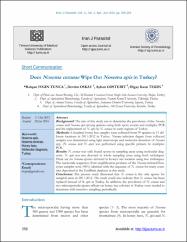Does Nosema ceranae Wipe Out Nosema apis in Turkey?
Abstract
Background: The aim of this study was to determine the prevalence of the Nosema ceranae and Nosema apis among apiaries using both spore counts and multiplex PCR and the replacement of N. apis by N. ceranae in some regions of Turkey. Methods: A hundred honey bee samples were collected from 99 apiaries in 11 different locations in 2011-2012 in Turkey. Nosema infection degree from collected samples was determined using light microscope and molecular detection of Nosema spp. (N. ceranae and N. apis) was performed using specific primers by multiplex PCR. Results: N. ceranae was only found spores in sampling areas using molecular diagnosis. N. apis was not detected in whole sampling areas using both techniques. There are no Nosema spores detected in Konya one location using two techniques. The nucleotide sequences from amplification products of the Nosema infested honeybee samples were (98%) identical with the sequence of N. ceranae for many countries deposited in the GenBank database in this study. Conclusion: The present study illustrated that N. ceranae is the only spores for sampled areas in 2011-2012. The study could also indicate that N. ceranae has been replaced instead of N. apis in Turkey. In addition, the prevalence of N. ceranae and two microsporodia spores effects on honey bee colonies in Turkey were needed to determine with intensive sampling, periodically.


















